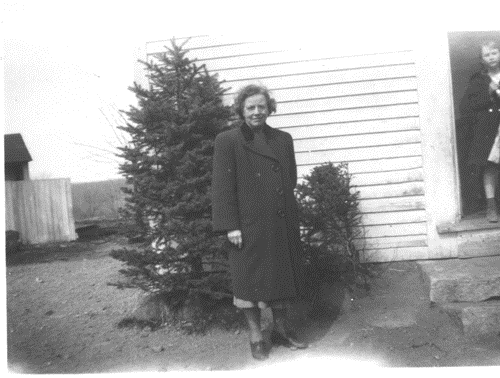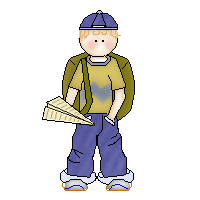 The One Room School House
The One Room School House
Gilead, Connecticut
 The One Room School House
The One Room School House
Gilead, Connecticut

Mrs. Montigny

 This
one-room school stood (and, somewhat altered, still
stands) at the corner of Routes 85 and 94 in Gilead,
Connecticut. The local story about the school is that it
was built in 1792. After it was built, though, there was
some disagreement among the local farmers about exactly
where it should stand, and opposing groups hitched teams
of oxen to either end of the building and dragged it
around until somehow it arrived where it is today. This
one-room school stood (and, somewhat altered, still
stands) at the corner of Routes 85 and 94 in Gilead,
Connecticut. The local story about the school is that it
was built in 1792. After it was built, though, there was
some disagreement among the local farmers about exactly
where it should stand, and opposing groups hitched teams
of oxen to either end of the building and dragged it
around until somehow it arrived where it is today.I went to most of second grade in this school in 1948 and 1949. In the fall of 1948 my family moved from Burlingham, NY, to my grandparents’ farm (the Buell Place) about a mile south of the school on Route 85 in Gilead. I had gone to first grade and about 2 months of second grade in Pine Bush, NY, in a modern, multi-room school. It was not a shock to transfer to a one-room school with no amenities; instead, it was fun. Who were the students? I remember Mickey Greenwood (mentioned below), Raymond Lavallee, Diane Rebillard, and Arthur Keefe. Also Raymond’s sister, whose name may have been Beverly. There are others (Doug Strickland, Kathy Ellis, Lynn Dziec) whom I knew the following year in third grade, but whose presence at the one-room school I am not certain of. The school had a single pot-bellied stove in the center of the room near the front. The wood was stacked outside to the left of the building in the photo above, and it was the job of the male students to carry wood in periodically. Mrs. Montigny lived (I think) in Columbia, and drove a 1927 Ford Model A, painted green and black. On cold mornings we kept our coats on until the rather small stove had heated the uninsulated building. There was no running water. In the cloakroom immediately inside the one door, there was a pail of water and a tin dipper. Every morning two boys crossed the road to Mr. Varney’s house. When I went to get water, my partner was always Mickey Greenwood. Mr. Varney had a well on his front lawn – complete with a stone enclosure, a roof, a rope and wooden pail. If the weather was warm, we just lowered the wooden pail and brought up water to pour into the metal pail we had brought with us. If it was cold, we first unwound the rope for the wooden pail from its wooden roller, and then threw the wooden pail down to break the ice. That was a lot of fun, since it might take five or six throws to break the ice. Eventually we would carry the metal pail of water back and leave it in the cloakroom. The "common dipper," incidentally, had been outlawed in schools by the Connecticut legislature in 1909 because of the threat of diphtheria. But it was still in use in Gilead. There were 28 students in the school, which included grades 1, 2, and 3. Mrs. Montigny was the only teacher, although occasionally a music teacher, Mrs.Surprenant, would arrive to give us a brief music lesson. Mostly I remember the sound of her pitchpipe; we didn’t learn much music. Books and other supplies were limited. I remember having a hard time finding any crayons except dark purple ones. Mrs. Montigny was a good teacher, despite the primitive conditions. She maintained a bird feeder, and we wrote diaries. She was a stickler for good penmanship, something I found hard. I remember the day she introduced a new subject called "Social Studies;" I didn’t have a clue what she was talking about. During the winter we played fox and geese in the snow and made snow angels. One day all of the male students got together during recess to roll a gigantic snowball. We got it over onto the part of the schoolyard that overlooked Route 85, where we waited for a car to come along so we could push the snowball down onto the car. But there was so little traffic that no car arrived before recess was over. Two years later Mrs. Montigny was my fourth grade teacher in the new Hebron Elementary School. The classroom was bigger and brighter, and the kids were a little older and more advanced in the ways of mischief. To ensure good behavior, she gave us an explanation that I still find imaginative: when she was facing the blackboard to write on it, she said, the combination of her glasses and the black board acted just like a mirror, so she could see what we were doing behind her. The one-room school went out of service in June,1949. Rob Foote owned the school, and the land it was on. When my grandparents (Albert and Jessie Adams) gave up farming at the Buell place in 1956, Rob Foote added a couple of rooms to the back of the school, and my grandparents lived there for several years. What had been my second-grade classroom was now their living room.
Written & Submitted by: Thomas Adams |
Back to Gilead Main Page
This page
was created by Linda Pingel.
April 29, 2002
It may not be copied without my permission.
Last Updated: April 29, 2002
